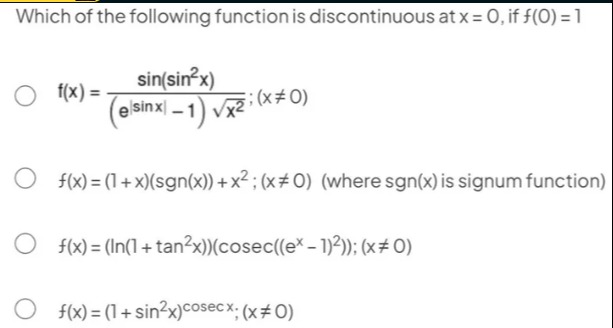Question
Question: Which of the following function is discontinuous at x = 0, if f(0) = 1 $f(x) = \frac{sin(sin^2x)}{(...
Which of the following function is discontinuous at x = 0, if f(0) = 1
f(x)=(e∣sinx∣−1)x2sin(sin2x); (x=0)
f(x)=(1+x)(sgn(x))+x2; (x=0) (where sgn(x) is signum function)
f(x)=(In(1+tan2x))(cosec((e\*−1)2));(x\neq$ 0)
f(x)=(1+sin2x)cosecx;(x\neq$0)

f(x) = (e∣sinx∣−1)x2sin(sin2x); (x=0)
f(x) = (1+x)(sgn(x)) +x²; (x=0) (where sgn(x) is signum function)
f(x) = (In(1 + tan²x)) (cosec((e*-1)²)); (x= 0)
f(x) = (1 + sin²x) cosecx; (x=0)
Options 2, 3, and 4 are discontinuous at x = 0.
Solution
Option 1:
For small x,
sin(sin2x)≈x2.
Also, e∣sinx∣−1≈∣x∣ and x2=∣x∣.
Hence,
So limx→0f(x)=1=f(0) (Continuous).
Option 2:
f(x)=(1+x)sgn(x)+x2.
- For x>0: sgn(x)=1, so f(x)=1+x+x2 with limx→0+f(x)=1.
- For x<0: sgn(x)=−1, so f(x)=−1−x+x2 with limx→0−f(x)=−1.
Since the one–sided limits are different, f(x) is discontinuous at 0.
Option 3:
f(x)=ln(1+tan2x)⋅csc((e−1)2) (here, csc((e−1)2) is a nonzero constant because sin((e−1)2)=0).
For small x, tanx≈x so ln(1+tan2x)≈x2. Hence,
Since f(0)=1 but the limit is 0, it is discontinuous at 0.
Option 4:
f(x)=(1+sin2x)cscx=sinx1+sin2x.
As x→0, the denominator sinx→0 while the numerator tends to 1, so f(x) blows up (tends to ∞ or −∞).
Hence, it is discontinuous at 0.
